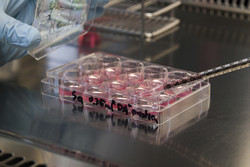How ‘glowing mice’ are shining a new light on brain research
Optimising stem cells to repair damage in mice brains following a stroke could help researchers find new ways of treating neurodegenerative diseases in humans, the final conference of the EU-funded GLOWBRAIN project has heard. The conference, which opened with two public lectures on the potential of using imaging techniques to visualise transplanted stem cells in mice brains, focused on the project’s concrete achievements and what these mean for the future of stem cell research. GLOWBRAIN coordinator Srećko Gajović gave a presentation entitled ‘Can the glowing mouse help fight the stroke?’. Attendees heard how the establishment of an innovation office and innovation manager has helped facilitate collaborations between Croatian researchers and other universities and intellectual property experts. The unique potential of stem cells – undifferentiated biological cells that can differentiate into specialised cells and divide to produce more stem cells – offers new possibilities for the future treatment of various diseases. Despite solid investment in stem cell research however, their practical application is still far from being realised. The GLOWBRAIN project, which began in October 2012, sought to establish a platform to bring together world class expertise in stem cell research. This includes cutting edge fields such as the in vitro culture of stem cells, the synthesis of biomaterials and analyses of cell behaviour, to name but a few. A key objective has been to advance research into degenerative disorders by tracing stem cell implants in mice. In addition, this platform will provide Croatian scientists with the network and knowledge to play a key role in developing new approaches towards treating brain diseases and neurodegenerative conditions such as Alzheimer's. Apart from Croatian researchers, the project includes renowned scientists from Austria, Czech Republic, Italy, Hungary, Germany, Portugal and Sweden. Researchers from these countries have taken part in a series of secondments, expert visits, workshops and conferences, carried out under the auspices of the GLOWBRAIN project. New equipment has also been purchased through the project in order to increase Croatia’s stem cell innovation capacities. The end result is that the coordinating institution, the Universtiy of Zagreb School of Medicine in Croatia, is now much better integrated within the European Research Area, with far better visibility among other leading research institutions. Furthermore, the GLOWBRAIN platform will encourage deeper scientific research in associated fields of research. For example, regenerative medicine has huge potential across a number of fields of clinical application, and is in need of further exploration. The establishment of a strong platform for cooperation with European partners, enabling Croatia to participate in stem cell and neuroscience research projects in the future, will be the lasting legacy of GLOWBRAIN. This field of work could revolutionise brain research and ensure faster commercialisation of results, placing the EU ahead in the regenerative medicine sector. The project is due for final completion in March 2016. For further information please visit: GLOWBRAIN http://glowbrain.hiim.hr/index.php/en/
Countries
Croatia



